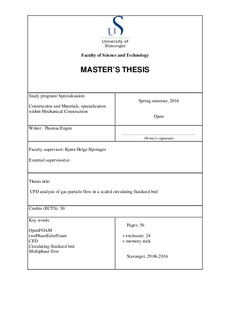| dc.contributor.author | Engen, Thomas | |
| dc.date.accessioned | 2016-09-28T11:36:42Z | |
| dc.date.available | 2016-09-28T11:36:42Z | |
| dc.date.issued | 2016-06 | |
| dc.identifier.uri | http://hdl.handle.net/11250/2411372 | |
| dc.description | Master's thesis in Mechanical engineering | nb_NO |
| dc.description.abstract | The hydrodynamics of gas-particle flow in a Circulating Fluidized Bed (CFB) system have been studied computationally. The numerical predictions are evaluated against experimental testing done on a 1/9th scale cold CFB boiler at Chalmers University, in 2001. The numerical model is created using the open-source CFD code OpenFOAM.
The simulations were done using two different approaches for how the flow is driven through the CFB system. First the simulations were run with a uniform plug velocity for the superficial gas velocity. This was done to see if OpenFOAM would generate the same type of turbulent regime that has been seen occurring in similar CFD codes created by previous researchers. The second approach was to set the superficial gas velocity to be calculated based on the pressure flux at the inlet boundary.
Numerical results of the pressure drop, solid concentration distribution in the riser, mean velocity and fluctuating velocity were taken for all the simulations. The numerical code is a two phase model. This was selected due to the fact that it has the capability of using the kinetic theory of granular flow. Previously work on this experimental setup were lacking when it came to predicting the correct pressure drop and solid volume concentration along the riser height.
For simulations that ran a superficial gas velocity calculated by the pressure flux the dense bottom bed were predicted. The pressure drop along the riser height compared well with experimental data when using a representative particle size of 70 µm. The velocity profiles is predicted to follow the same trends as the experimental results, but they are sensitive to the particle size. For particle size of 45 µm the axial velocity is generally overestimated, and for 70 µm the axial velocity is underestimated towards the walls, but fits well in the center of the riser.
Based on the validation against experimental data, it is assumed that the obtained results are physically correct for the case simulated with a calculated pressure flux for the superficial gas velocity. The experiment is done with a wide particle size distribution, so modeling the gas-particle flow with only one mean particle velocity will influence the comparability of the results. | nb_NO |
| dc.language.iso | eng | nb_NO |
| dc.publisher | University of Stavanger, Norway | nb_NO |
| dc.relation.ispartofseries | Masteroppgave/UIS-TN-IKM/2016; | |
| dc.subject | maskinkonstruksjon | nb_NO |
| dc.subject | maskinteknikk | nb_NO |
| dc.subject | OpenFOAM | nb_NO |
| dc.subject | multiphase flow | nb_NO |
| dc.title | CFD analysis of gas-particle flow in a scaled circulating fluidized bed | nb_NO |
| dc.type | Master thesis | nb_NO |
| dc.subject.nsi | VDP::Technology: 500::Mechanical engineering: 570 | nb_NO |
